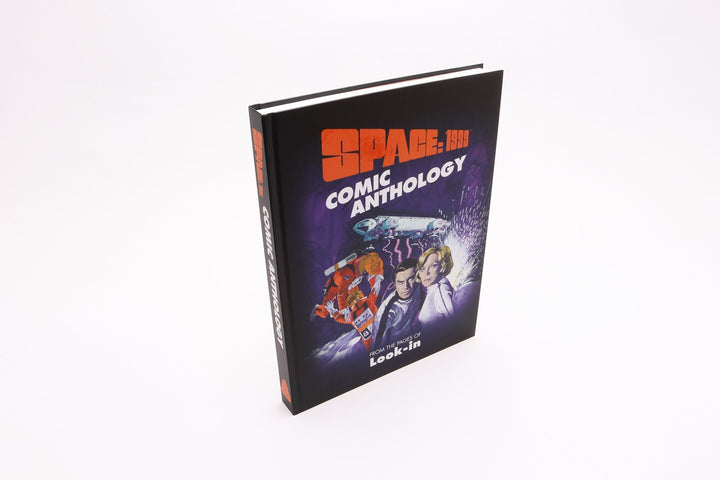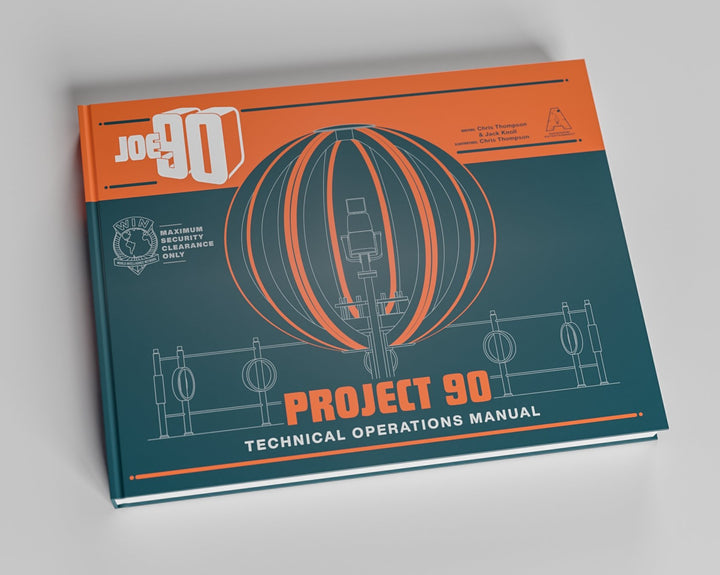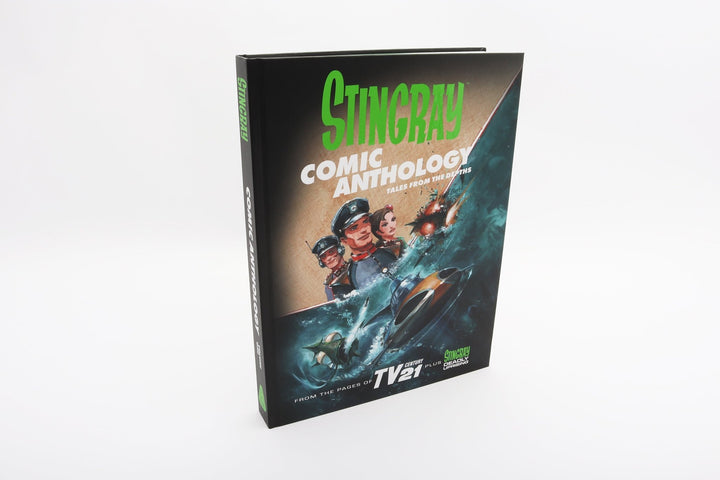An Indestructible Violence: The Enduring Darkness of Captain Scarlet

It can be relied upon like clockwork. Across any number of social media platforms, posts will emerge highlighting, with humorous abandon, just how violent Captain Scarlet and the Mysterons is. Whether it's compilations of scenes involving graphic shoot-outs between Spectrum and Mysteron agents or videos examining the darkness of the series, it's certainly become a regular pattern over the last few years that people become feverishly reminded of the kind of series Captain Scarlet is. While these brief bursts are a welcome reminder of Captain Scarlet's long-lasting popularity, they seem to tell another, more interesting story involving the relationship that viewers can have with a TV series. The reactions to these posts/videos share a common startling realisation, raising such common questions as "Wait - this was a kid's show?!" and "Wow, this is dark!"
Captain Scarlet is indisputably dark - but why are we so constantly surprised to be reminded of how dark it is? Taking this a step further, can Captain Scarlet actually be thought of as genuinely 'dark' at all, or do we underestimate how aggressive and intense we allow children's television to be? And what is it about Captain Scarlet's focus on violent spectacle that gifts the series with such lasting endearment from fans?
Spectrum is Dark

To start with, when we use the term 'dark', what do we mean here? Captain Scarlet is not the only Gerry Anderson series to feature alien menaces or puppet characters using firearms against each other, after all. But Captain Scarlet bears a grim atmosphere that's at odds with a commonly held summary of why Gerry Anderson's worlds remain so popular. Anderson's worlds, especially his Supermarionation works throughout the 1960s, are held in regard as fine examples of technologically-advanced utopias, where much of humanity lives in harmony and many of the world's ills have all but been eradicated. Captain Scarlet presents us with a world riddled in paranoia and trigger-happy militant peacekeeping, where the global security organisation Spectrum becomes the accidental root cause of an interplanetary war with a race of aliens whose omnipotence makes for an unpredictable and terrifying enemy to battle against. In the world of Captain Scarlet, anyone can be a Mysteron agent without anyone else knowing.
Matching this darkly intense premise is one of Supermarionation's great leap forwards as an art form. Now totally abandoning the caricatured nature of their puppet characters' designs, Century 21 Productions (formerly AP Films, another sign of evolutionary steps being taken) was now crafting their puppet heroes as perfectly proportioned humans. What these creations now lacked in manoeuvrability, they made up for in their sophisticated yet uncanny valley visual style as ultra-perfect, miniature humans.
This is the Voice of Century 21
The reasons for these leaps forward for Century 21 Productions' output have much to do with the relative failure of Thunderbirds to become a sustained success for the company. Following an unsuccessful sale to American network television and a stumbling presence in cinemas with two lowly received films, Thunderbirds' lifespan was cut short. Some new, dynamic, fresh product had to fill the void - something that could match, or, ideally, eclipse the confined success of Thunderbirds and enable a definitive, global break-out success for the company whom media mogul Lew Grade had sunk a vast amount of financial capital in by this time.
Something innovative that could grab audiences was demanded of Century 21 Productions in much the same way that Thunderbirds had done. The aforementioned technological advances in their approach to puppetry enabled the company to remain on the cutting edge of television entertainment, but what kind of fictional concept would suit these advancements? Gerry's initial concept for the series that would become Captain Scarlet was a live-action police drama in which the hero, played by some superstar of the era, would be killed off halfway through the series' run, allowing a new and equally popular star to fill the role. Grade turned this idea away in a heartbeat, but the ever resourceful Anderson salvaged and reshaped the concept into something new - what if the hero was still killed off, but they came back?

There's an alternate universe somewhere out there in which this proposed live action crime drama was the true follow-up to Thunderbirds. It's worth noting that the Andersons and Century 21 never proactively sought to pigeonhole themselves as purveyors of science fiction. Rather, their body of work suggests a company that strove to be deliberately diverse that could cater to varying audiences, but found their greatest success in kid-orientated sci-fi at a time when the Space Race was gripping public imagination. Whatever emerged from the wreckage of Thunderbirds' crash-landing had to have its finger on the pulse. In this case, the finger would be on the trigger. Whether through purposeful design or happy accident, Captain Scarlet would become renowned for its violence between its heroes and villains and for its darker attitude to storytelling and characterisation than past efforts.
Acts of Aggression
Death is as commonplace in Captain Scarlet as the launch sequences are in Thunderbirds. By comparison, however, Captain Scarlet's portrayal of death and destruction allows for a huge amount of creativity in storytelling, direction, and special effects. Where Thunderbirds' launch sequences remained mostly the same stock footage copied and pasted into each episode, each and every death in Captain Scarlet is a unique event. The Mysterons deploy macabre, prolonged methods of execution of unsuspecting humans who are chosen to become Mysteron doppelgangers. The Mysterons' ability to recreate objects or persons out of destroyed remains necessitates some creative thinking in how they deliver on their war of nerves.

The Mysterons' embracing of death as a slow, agonising process of inevitable destruction remains one of Captain Scarlet's most compelling elements. Series episodes Winged Assassin, The Launching, Model Spy, and Point 783 all feature unique and creative scenarios in which something starts to go wrong. Slowly, then horribly. The scenario snowballs into unstoppable scenes of carnage. Delta Tango 19's pilots can do nothing to stop the passenger plane's gradual breakdown mid-air. Fashion models Gabrielle and Helga's monotrain suddenly increases its speed before crashing off the rails. From each of these smashed remains, the Mysteron replicas emerge to carry out their threats. It's not enough that these unflinching depictions of death should have a place in the series; it's their haunting inexplicableness.

From behind the scenes, these moments allow for the series' special effects and puppetry units to showcase a range of technical and visual abilities, but another angle is that a terrible unknown quality surrounded these executions. These poor individuals can never know that they are about to be repurposed into the service of invisible aliens. It's attitudes like this that inject the Mysterons' methods with such menace.
It's a similar story with Captain Scarlet himself. Virtually indestructible, only electrocution remains the sure-fire way of permanently disposing of Spectrum's number one agent. Instead, poor Paul Metcalfe is subjected to regular gunfire, detonated nuclear devices, collapsing castles, and exploding champagne. Nevertheless, as gratuitous as these scenes of violence are, death is vital in Captain Scarlet. The Mysterons *have* to kill to bring someone under their control, and Scarlet is often faced with committing the ultimate physical sacrifice to save the day.
Captain Scarlet's preoccupation with death therefore isn't simply to shoehorn in some surface-level shock value. Behind the scenes, it demanded regular creativity from the series' production staff, and within the world of Captain Scarlet itself, death is entirely justified.
One Man, Fate Has Made Indestructible
Amidst all of this carnage, Captain Scarlet has managed to come away relatively unscathed by the passage of time. Much like the indestructible man himself, Captain Scarlet has enjoyed numerous lifespans on television and on home release - from the series' initial ITV regional broadcast in 1967 to numerous other regional reruns throughout the 70s and 80s, to the series' debut national showing on BBC 2 in the early 1990s and again in the early 2000s. The series remains available on DVD, Blu-ray, and streaming platforms and is currently enjoying a fresh outing on Talking Pictures TV.

Surprisingly, the series has never appeared to court much severe controversy for its depiction of violence. The closest the series came was during its BBC 2 reruns in the early 2000s, when Winged Assassin and Big Ben Strikes Again had to be pulled from their planned early broadcast due to their unfortunate similarities to 9/11. Captain Scarlet wasn't an isolated case of children's TV series having to react to the very real tragedy, but in Captain Scarlet's case in particular, both episodes were bolted onto the end of the series' network run, rather than discarded entirely. Current DVD/Blu-ray release of the series has the BBFC classify it as 'U' whilst the Irish Film Censor's Office rates the series as 'G' - 'fit for viewing by persons generally'.
For all of its exposed bloodshed and creeping sense of dread, Captain Scarlet is officially classed as universally acceptable for all audiences to enjoy. Doesn't that seem bizarre? Why should a TV series that showcases violence in such extreme ways be so easily accessible? How many other TV series can claim to regularly showcase the death of its namesake whilst still passing freely under the censors? By comparison, New Captain Scarlet is officially regarded as '12' - the same rating given to UFO! How is it that something as potentially petrifying as Captain Scarlet remains so easily ready to be consumed?

Despite being made with 'kidult' audiences in mind, Captain Scarlet has come to be pigeonholed as strictly children's television, as has much of Gerry Anderson's body of work from the 1960s. Captain Scarlet doesn't deal with human trauma as deeply as UFO would go on to do, nor does it question humanity's place in an amoral universe like Space: 1999 does. These two series in particular are often regarded as the peak of Gerry Anderson's creative powers and definitive signs of unmooring himself from the constraints of creating children's entertainment. But surely Captain Scarlet was its own attempt to showcase what he and Century 21 Productions could achieve when daring to venture into morally ambiguous territory in questioning who are the real heroes and villains in war. The Mysterons are shown to not be naturally antagonistic. It was Spectrum who fired the first shot. Who's the real enemy here? Heavy thinking for a TV series that had accompanying toys from Dinky.
But it's hard to break free when you become typecast. Despite pursuing an eclectic career ranging from live action to stop-motion and CGI, Gerry Anderson remains most closely associated with children's television puppetry. That stereotype is perhaps what really cushions Captain Scarlet's vigorous embracement of violence, destruction, and death. For fans not intimately familiar with Gerry's work, maybe it's that exact stereotype that throws expectations into shock and surprise when people discover the dark, adventurous horrors that await them when they take that solitary stroll down the seemingly abandoned alleyway in the dead of night before being confronted by the shadowy figure of the man in scarlet.
To be the first to hear about the latest news, exclusive releases and show announcements, sign up to the Anderson Entertainment newsletter!




![Thunderbirds Comic Anthology Volume One [HARDCOVER] - The Gerry Anderson Store](http://gerryanderson.com/cdn/shop/files/thunderbirds-comic-anthology-volume-one-hardcover-8030771.jpg?v=1751089031&width=720)
![All Sections Alpha: The Making of Space: 1999 [HARDCOVER] - The Gerry Anderson Store](http://gerryanderson.com/cdn/shop/files/all-sections-alpha-the-making-of-space-1999-hardcover-7498116.png?v=1757766647&width=720)

![Stingray Comic Anthology Volume Two – Battle Lines [HARDCOVER] - The Gerry Anderson Store](http://gerryanderson.com/cdn/shop/files/stingray-comic-anthology-volume-two-battle-lines-hardcover-107681.jpg?v=1738856151&width=720)
![Stingray W.A.S.P. Technical Operations Manual Standard Edition [HARDCOVER] - The Gerry Anderson Store](http://gerryanderson.com/cdn/shop/files/stingray-wasp-technical-operations-manual-standard-edition-hardcover-112278.jpg?v=1749664163&width=720)
![Stingray WASP Technical Operations Manual Special Limited Edition [HARDCOVER BOOK] - The Gerry Anderson Store](http://gerryanderson.com/cdn/shop/files/stingray-wasp-technical-operations-manual-special-limited-edition-hardcover-book-991914.jpg?v=1749657538&width=720)
![Stingray: The Titanican Stratagem – Signed Limited Edition [HARDCOVER NOVEL] - The Gerry Anderson Store](http://gerryanderson.com/cdn/shop/files/stingray-the-titanican-stratagem-signed-limited-edition-hardcover-novel-129251.jpg?v=1740558711&width=720)







